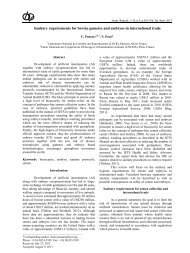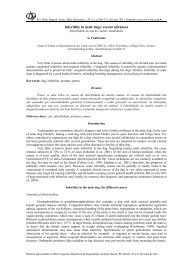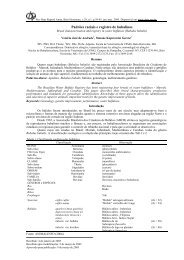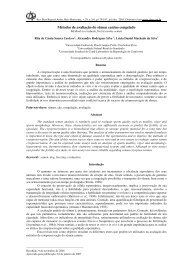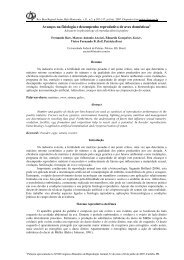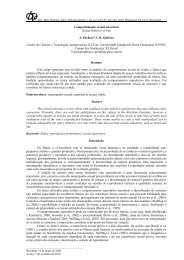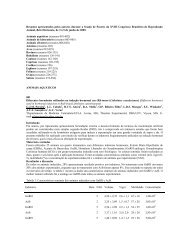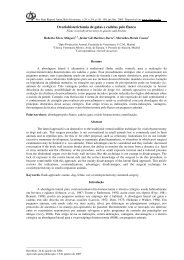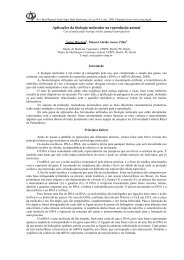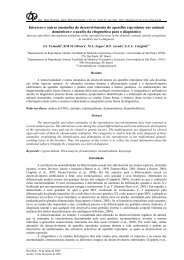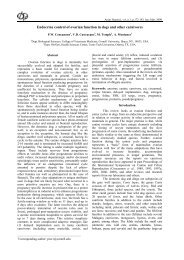Recent advances in ovulation synchronization and superovulation in ...
Recent advances in ovulation synchronization and superovulation in ...
Recent advances in ovulation synchronization and superovulation in ...
You also want an ePaper? Increase the reach of your titles
YUMPU automatically turns print PDFs into web optimized ePapers that Google loves.
Abstracts. II International Symposium on Animal Biology of Reproduction, Nov. 19-22, 2008, São Paulo, SP, Brazil.<br />
Apoptosis <strong>and</strong> autophagy are required dur<strong>in</strong>g the follicular atresia <strong>in</strong> teleost ovary<br />
R. Thomé 1 , H. Santos 1 , F. Arantes 1 , Y. Sato 2 , N. Bazzoli 3 , E. Rizzo 1<br />
1<br />
Laboratory of Ictiohistology, Morphology Department, ICB/UFMG, CP 486, Belo Horizonte, MG, Brazil; Hydrobiology <strong>and</strong><br />
Hatchery Station of Três Marias – CODEVASF; 3 Graduate Program on Zoology of Vertebrates – PUC M<strong>in</strong>as, Belo Horizonte,<br />
MG, Brazil.<br />
Introduction<br />
Follicular atresia is a hormonally controlled degenerative process by which vertebrate ovarian follicles lose their<br />
<strong>in</strong>tegrity <strong>and</strong> are elim<strong>in</strong>ated prior to <strong>ovulation</strong>. Apoptosis or type I cell death is a well-characterized pathway to cell<br />
death essential to ma<strong>in</strong>tenance of tissue homeostasis <strong>in</strong> multicellular organisms. Autophagic or type II cell death has<br />
been considered as an alternative route of programmed cell death, dist<strong>in</strong>ct from apoptosis <strong>and</strong> characterized by the<br />
formation of many large autophagic vacuoles (1). The purpose of the present study was to <strong>in</strong>vestigate the<br />
contribution of apoptosis <strong>and</strong> autophagy dur<strong>in</strong>g follicular atresia <strong>in</strong> two freshwater teleost species from the São<br />
Francisco River bas<strong>in</strong>, Brazil: curimatã-pacu, Prochilodus argenteus <strong>and</strong> piau-jejo, Lepor<strong>in</strong>us taeniatus.<br />
Material <strong>and</strong> Methods<br />
Fishes were ma<strong>in</strong>ta<strong>in</strong>ed <strong>in</strong> captivity after the reproductive period <strong>and</strong> follicular atresia was assessed for three stages:<br />
early, advanced, <strong>and</strong> late atresia. The morphological features of the atretic follicles were histologically exam<strong>in</strong>ed <strong>in</strong><br />
ovarian samples fixed <strong>in</strong> Bou<strong>in</strong>’s fluid for 8 h at room temperature, embedded <strong>in</strong> paraff<strong>in</strong>, sectioned, <strong>and</strong> sta<strong>in</strong>ed<br />
with hematoxyl<strong>in</strong>-eos<strong>in</strong>. For the identification of autophagy <strong>in</strong> the follicular cells, the ovarian samples were fixed <strong>in</strong><br />
Karnovsky, post-fixed <strong>in</strong> 1% osmium tetroxide with 1.5% potassium ferrocyanide for 2 h, <strong>and</strong> then embedded <strong>in</strong><br />
Epon/Araldite plastic res<strong>in</strong>. Ultrath<strong>in</strong> sections were sta<strong>in</strong>ed with uranyl acetate <strong>and</strong> lead citrate <strong>and</strong> exam<strong>in</strong>ed us<strong>in</strong>g a<br />
transmission electron microscope. The TUNEL <strong>in</strong> situ technique was used to assess apoptosis dur<strong>in</strong>g the follicular<br />
atresia <strong>in</strong> ovaries of the P. argenteus <strong>and</strong> L. taeniatus.<br />
Results <strong>and</strong> Discussion<br />
The atretic follicles exhibited zona pellucida breakdown, yolk degeneration, <strong>and</strong> hypertrophied follicular cells,<br />
common features of the follicular atresia <strong>in</strong> most of the teleosts (2). Morphometric analyses of the ovarian regression<br />
showed decreased atretic vitellogenic follicles <strong>and</strong> <strong>in</strong>creased per<strong>in</strong>ucleolar follicles for the future reproductive cycles<br />
<strong>and</strong> yellow bodies to both species. In contrast to mammals, oogonia cont<strong>in</strong>ue to proliferate <strong>in</strong> adult females <strong>and</strong><br />
produce per<strong>in</strong>ucleolar follicles, which stock oocytes for the next reproductive cycle (3). Intense heterophagy to<br />
engulf the yolk, <strong>and</strong> autophagy were detected <strong>in</strong> the follicular cells dur<strong>in</strong>g advanced <strong>and</strong> late atresia. The TUNEL<br />
assay detected DNA fragmentation, ma<strong>in</strong>ly <strong>in</strong> late follicular atresia. Differently, the apoptosis contribute greatly for<br />
the rapid elim<strong>in</strong>ation of the postovulatory follicles <strong>in</strong> spawned ovaries of P. argenteus (4). We <strong>in</strong>ferred that<br />
heterophagy, autophagy, <strong>and</strong> apoptosis contributed to follicular atresia <strong>in</strong> teleost ovaries, thereby achiev<strong>in</strong>g a more<br />
efficient removal of the degenerat<strong>in</strong>g oocyte <strong>and</strong> dy<strong>in</strong>g follicular cells.<br />
References<br />
(1) Locksh<strong>in</strong> RA, Zakeri Z. 2004. Int J Biochem Cell Biol, 36:2405-2419; (2) Bazzoli, N. 2003. In: God<strong>in</strong>ho HP.<br />
God<strong>in</strong>ho AL. Waters, fishes <strong>and</strong> fishers of the São Francisco <strong>in</strong> M<strong>in</strong>as Gerais. Belo Horizonte, MG: PUC-M<strong>in</strong>as [<strong>in</strong><br />
Portuguese]; (3) Jalabert B. 2005. Reprod Nutr Dev, 45: 261-279; (4) Santos et al. 2008. Tissue Cell, 332:159-170.<br />
Support: FAPEMIG, CNPq <strong>and</strong> CODEVASF.<br />
E-mail: ictio@mono.icb.ufmg.br<br />
Anim. Reprod., v.6, n.1, p.211, Jan./Mar. 2009 211



